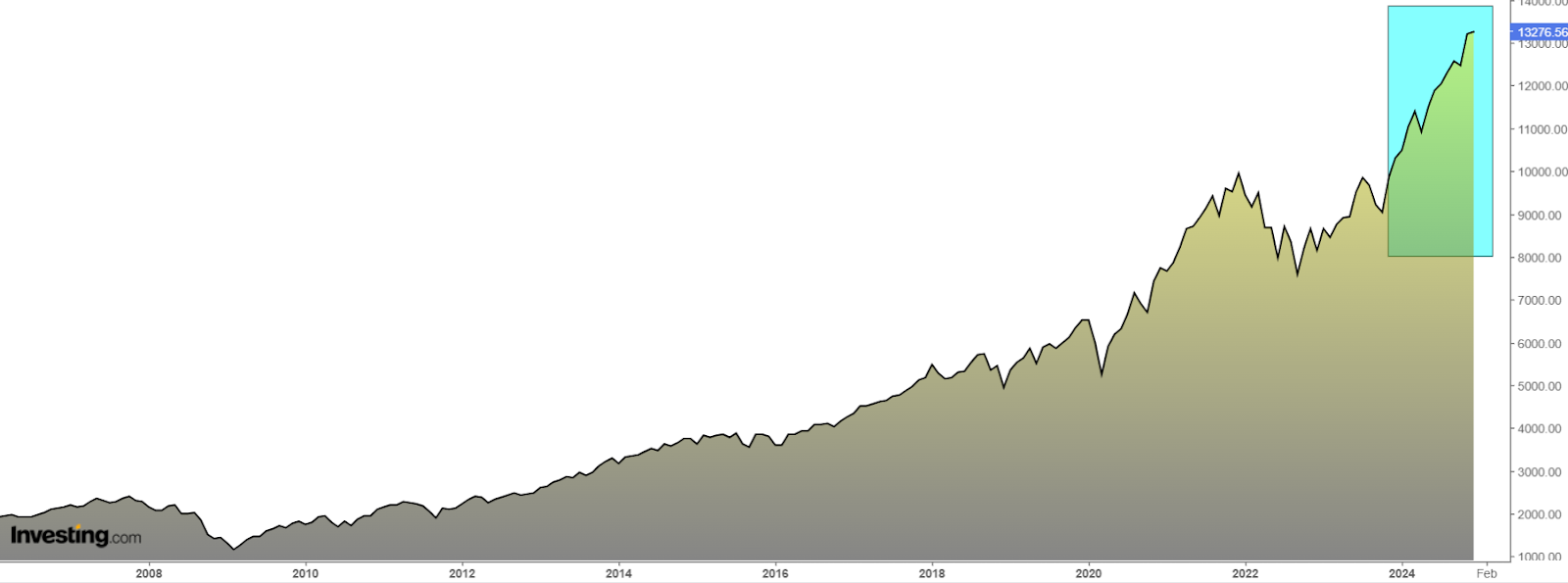- In historical terms, the S&P 500's massive surge this year is not as uncommon as it seems
- Economic resilience and robust corporate earnings are poised to fuel further market gains into 2025.
- Investor sentiment remains strong, with bullish expectations above historical averages, signaling continued confidence in the market's upward trajectory.
- Take advantage of our Extended Cyber Monday offer —your last chance to secure InvestingPro at a 55% discount!
Factoring dividends, the S&P 500 is up 29% this year as of this writing.
While this increase might appear extraordinary or excessive, it's actually more common than many might think. In fact, the index has achieved a total return of over 25% in 26 out of the 96 years since 1928, which equates to 27% of the time.

And that's not all. According to data from Deutsche Bank, over the past 100 years, the market has been more likely to achieve annual returns of 10% to 20% rather than 0% to 10%.
Despite a few corrections that were not severe (in April, September, and the more significant one in August), which investors capitalized on to buy at lower prices, it has maintained its upward trend without issue.
Factors that historically might have caused a more significant market decline, such as uncertainty over U.S. elections and inflation, didn't have a major impact this time.
As it stands, the S&P 500 is on track for a 30% gain for the year, with the Nasdaq Composite expected to rise by 35%.
Can the bull market persist into 2025?
To address this, we need to consider two key questions:
1. What were the catalysts that have buoyed the market this year?
- Trump's Victory.
- Lowering of interest rates as inflation came under control
- A U.S. economy performing better than many expected
- Listed companies delivering better-than-expected results on the corporate earnings side, often surpassing forecasts
- The rise of artificial intelligence, leading to substantial gains in several stocks, including those heavily weighted in the indexes
2. Are these catalysts expected to continue through 2025?
Yes.
- Wall Street forecasts a 15% growth in S&P 500 earnings next year
- Trump has promised to reduce corporate taxes from 21% to 15%, which will likely enhance company profits
- More favorable financial sector regulations, requiring less fund provisioning, will likely boost their stock values
- Though the Fed has limited room to further cut interest rates, inflation seems to be under control.
- The market anticipates a 98% chance of a 25 basis point rate cut at the December 17-18 meeting.
Therefore, I believe the S&P 500 is expected to remain robust in 2025.
This is the typical period when Wall Street starts speculating on where the S&P 500 will end by 2025. The most optimistic prediction comes from Oppenheimer, projecting it at 7100.
Small caps, such as those in the Russell 2000 , are also expected to perform well in 2025, as their businesses primarily rely on the domestic economy rather than international developments.
Regarding the so-called Magnificent 7—Alphabet (NASDAQ: GOOGL ), Amazon (NASDAQ: AMZN ), Apple (NASDAQ: AAPL ), Meta Platforms (NASDAQ: META ), Microsoft (NASDAQ: MSFT ), Nvidia (NASDAQ: NVDA ), and Tesla (NASDAQ: TSLA )—their combined valuation has surpassed $18 trillion for the first time in history.
This means their market value now exceeds the annual gross domestic product of every country except the United States and China.
There is every reason to believe that these companies' dominance in the global stock market could continue into 2025.
Investor sentiment (AAII)
Bullish sentiment, i.e. expectations that stock prices will rise over the next six months, is at 43.3% and remains above its historical average of 37.5%.
Bearish sentiment, i.e. expectations that stock prices will fall over the next six months, is at 31.7%, slightly above its historical average of 31%.
Stock Market Rankings in 2024
Here is the year-to-date ranking of the major stock exchanges:
- - Nasdaq 32.74%.
- - S&P 500 26.86%.
- - Dax German 21.81%
- - Nikkei Japanese 17.95%
- - Hang Seng Chinese 17.15%
- - Ibex 35 Spanish 16.33%
- - Dow Jones 16.29%
- - FTSE MIB Italian 14.95%
- - Euro Stoxx 50 9.88%
- - FTSE 100 British 7.33%
- - Cac french -1.77% french -1.77% french -1.77% french -1.77%
***
Curious to learn how top investors are structuring their portfolios for 2025?
Take advantage of our Extended Cyber Monday offer —your last chance to secure InvestingPro at a 55% discount—and gain insights into elite investment strategies and access over 100 AI-driven stock recommendations every month.
Interested? Click on the banner below to discover more.